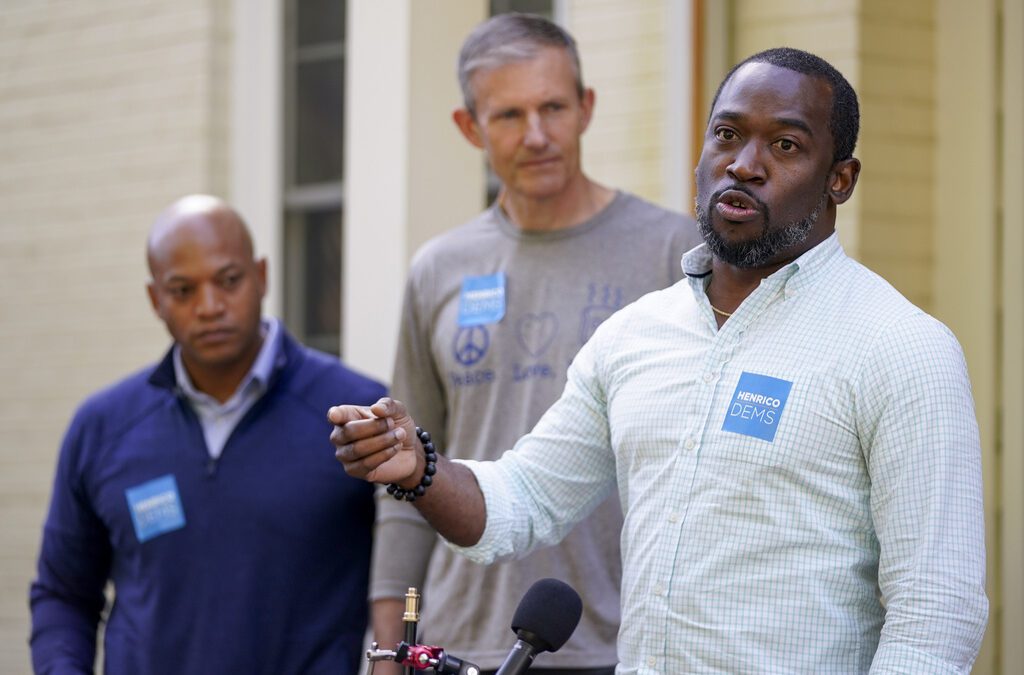
Virginia Gov. Glenn Youngkin speaks during news conference announcing the Department of Education report on education Thursday May 19, 2022, in Richmond, Va. (AP Photo/Steve Helber)
The state education report paints a bleak picture…but is that accurate?
RICHMOND — If it was a report card, the Commonwealth of Virginia would’ve been grounded.
Gov. Glenn Youngkin, State Superintendent for Public Instruction Jillian Balow, State Education Secretary Aimee Guidera, and Acting State Director of Diversity, Equity, and Inclusion Dr. Rosa Atkins presented a report titled “Our Commitment to Virginians: High Expectations and Excellence for All Students,” on May 19, part of the Virginia Department of Education’s (VDOE) work tasked by the governor on his first day in office.
The report sought to demonstrate specific steps to raise standards in order to close the achievement gap in K-12 education, as well as ensure that every Virginia student demonstrated college-readiness upon graduation.
Some of the major findings of the report show that expectations were lowered for students and schools, that Virginia’s national standing on education is declining and some student assessments are trending downward, and that enrollment numbers dropped.
“We cannot know where we’re going, unless we know where we’re starting; and where we’re starting is not where we thought we were,” Youngkin said at the event.
Lowered Expectations
While the VDOE report touted the “honesty gap,” a discrepancy between scores considered to demonstrate student proficiency, between the National Assessment of Educational Progress (NAEP)—also known as the Nation’s Report Card—and state assessments, The Washington Post pointed out that Youngkin’s team misinterpreted the data.
According to the Post: “[The] two tests have different meanings of what it means to be ‘proficient’ in a subject, so comparisons aren’t valid. NAEP has long been the subject of criticism over its achievement levels — and for too many years those levels have been equated to grade-level skills. They aren’t.”
It’s easy to see how the discrepancy could paint a picture without context. For example, the 2019 NAEP found that only 38% of Virginia fourth graders and 33% of eighth graders were proficient in reading, compared to 75% and 76%, respectively, on the 2019 state SOL reading tests.
However, exceptions for Virginia schools have lowered in past years, according to the report, which mentions changes surrounding the 2017 Standards of Accreditation. In 2015, former Gov. Terry McAuliffe signed a bill to deemphasize standardized test results for accrediting public schools in Virginia. While 88 schools were denied accreditation prior to the change of standards, no school has been denied accreditation since then, according to PolitiFact.
Currently, the report also noted that the SOL review process “does not sufficiently leverage many critical customers of our schools—including parents, employers, colleges and universities, and the military—to ensure our standards are aligned to the skill and content needs of the knowledge economy.”
This isn’t the first time a variety of stakeholders came into Virginia’s education conversation this year. Dogwood reported in April that Guidera planned to look at math and history in Virginia schools as part of a robust seven-year review process, which would enhance opportunities for input from national content experts, commonwealth professors, directors of education at cultural historical sites who possess subject matter expertise, and representatives from the military, higher education, and employment sector.
Declining National Standing and Student Assessments
The numbers that emerged in the report weren’t the greatest. For example, in 2014, Virginia was third in the nation for students earning college credits on Advanced Placement exams. In 2021, the commonwealth ranked ninth.
In fall 2021, 42% of Virginia second graders scored below the reading benchmark on the Phonological Awareness Literacy Screener (PALS) assessment. Some of the largest disparities fell on minority and low-income students. Regarding the above second grade PALS assessment, 55.6% of Black, 56.5% of Hispanic, and 56.8% of economically disadvantaged students were below the reading benchmark.
Additionally:
- 45% of Black third-grade students passed their SOL reading assessment in 2021, compared with
61% in 2017 - 43% of Hispanic third graders passed in reading in 2021, compared to 66% in 2017
- 45% of economically disadvantaged third-grade students passed in 2021, compared to 62% in 2017
- 72% of white third graders passed in 2021, compared to 81% in 2017
Despite the trends listed, Atkins, who has three decades of experience as an educator, encouraged perseverance.
“I know firsthand the impact a report like this can have on individuals, families, and communities. It is hard, but we owe it to our learners to listen and to act upon the truth,” Atkins said at the event.
She noted that there was a powerful potential in Virginia students, but said that there needed to be a change away from old ideas and practices.
Leaving Class
Another issue noted in the report is that some students are leaving or have not returned to school since the start of the COVID-19 pandemic.
The report vaguely noted that “Virginia parents are taking their kids out of public schools” before listing some statistics. During the 2019-20 school year, more than 38,000 Virginia students were homeschooled, followed by more than 59,000 in 2020-21. This year, more than 55,000 students chose the homeschool option.
Numbers were also available for the amount of students that transferred from Virginia public schools to in-state private schools since the beginning of the 2020-21 school year, and that was 5,828 students. Comparatively, there were more than 1.2 million students enrolled in Virginia public schools in 2021.
There’s no question that fewer students are attending public schools in the commonwealth. According to a report by the Virginia Department of Education, enrollment declined by more than 46,000 students from fall 2019 to fall 2021. That’s more than a 3% decrease overall.
To further expand on the decline, the “Our Commitment to Virginians” report linked the University of Virginia Weldon Cooper Center for Public Service’s January 2022 report and presentation. The findings noted that prior to the pandemic, enrollment in Virginia public schools was on track to begin declining in the early 2020s. As early as 2013, Virginia kindergarten numbers were substantially smaller than the previous year.
“By this fall, even without the pandemic, Virginia’s public school enrollment was expected to enter an indefinite period of enrollment decline—with close to 50,000 fewer students by 2030,” the UVA report read in part.
The predictions in the UVA report noted that the main reason for the foretold enrollment dip was that the number of births in Virginia declined beginning in the 2000s, and that school enrollment closely followed the birth rate.
Seven Principles
During Youngkin’s speech about the VDOE report, he laid out seven principles aimed toward “restoring excellence” to education in Virginia.
The seven principles included:
- Establish and maintain high expectations for students, schools, and ourselves
- Advance parent and teacher empowerment to best serve students in partnership
- Demand zero-tolerance for discrimination in education and beyond
- Foster innovation in all education environments
- Provide transparency and accountability so that each child is seen and receives what they need to succeed
- Ensure postsecondary readiness so that all learners can succeed in life
- Protect and nurture freedom of speech and inquiry to ensure every student is taught how to think, not what to think
Critical Remarks
The 33-page document also received its fair share of criticism from Virginia Education Association (VEA) President James Fedderman.
Fedderman stated in part: “This ‘report’ does little to advance its stated goal, but goes to great lengths to disrespect and belittle the amazing work Virginia educators have done, and continue to do, under incredibly difficult circumstances. By ignoring the solid educational achievements made by Virginia students over the past several years while promoting politically convenient terms like ‘honesty gap,’ this report only serves to further the governor’s political agenda while failing to address any of the real needs in the commonwealth’s classrooms.”
He also noted a “shocking lack of commitment to best practices” surrounding analysis, alleging that the report used anomaly years to assert trends, highlighted former analysis rather than current data, and ignored variables including state test standards and format changes.
“Through blatant manipulation of data and failing to uplift the most obvious achievement gap challenges in Virginia, it’s clear the real intent of the report is political in nature,” Fedderman stated in part. “If Gov. Youngkin is concerned about an ‘honesty gap,’ he need look no further than his own office to find it.”
Politics

Biden administration bans noncompete clauses for workers
The Federal Trade Commission (FTC) voted on Tuesday to ban noncompete agreements—those pesky clauses that employers often force their workers to...

Democratic shakeup in Virginia primaries for governor, lieutenant governor
Richmond Mayor Levar Stoney quit his bid for governor and jumped into the race to be the Democratic nominee for lieutenant governor. The race for...
Local News

The zodiac signs of 12 iconic women offer insight into their historic accomplishments
Zodiac signs can tell you a lot about someone’s personality. Whether they’re an earth, water, air, or fire sign, these 12 categories (which are...

Virginia verses: Celebrating 5 poetic icons for National Poetry Month
There’s no shortage of great writers when it comes to our commonwealth. From the haunting verses of Edgar Allan Poe, who found solace in Richmond's...





